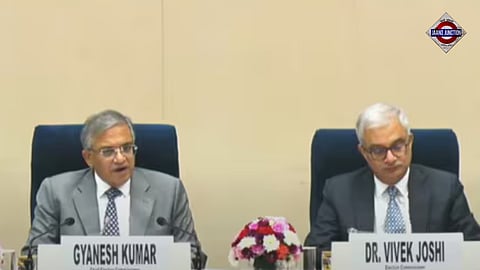

Bihar will vote in a two-phase election on November 6 and 11, the Election Commission of India (ECI) announced on Monday, adding that the results for the high-stakes electoral battle will be announced on November 14.
The ECI announced that Bihar has a total of 7.43 crore voters this election with 14 lakh first time voters. Chief Election Commissioner Gyanesh Kumar also said that this will be the best election for voters. “Bihar elections will be easy for voters. Full monitoring of law and order will be maintained. Bihar election will be reflected as the best election," he said while announcing the poll dates.
The upcoming assembly elections are expected to be a tight contest between the ruling BJP-JD(U) and the opposition Mahagathbandhan led by the Rashtriya Janata Dal and the Congress. Adding a new dimension to the race is election-strategist-turned-neta Prashant Kishor’s Jan Suraaj Party, which is positioning itself as an alternative force in Bihar politics.
In the 2020 polls, held amid the Covid-19 pandemic, the BJP had won 75 seats out of 110 that it had contested, and its strength rose over the years on account of defections from other parties as also victories in bypolls. The NDA as a whole had secured a majority with 125 seats, while the Mahagathbandhan had won 110. The RJD emerged as the single largest party with 75 seats.
Besides the BJP, the NDA in Bihar—which is contesting the polls under the leadership of chief minister Nitish Kumar who heads the JD(U)—also includes Union minister Chirag Paswan’s Lok Janshakti Party (Ram Vilas) and Rashtriya Lok Morcha headed by Rajya Sabha MP Upendra Kushwaha.
Media had earlier reported that the BJP and Janata Dal (United) seem to have reached a consensus on seat sharing, with a formal announcement expected soon. According to the emerging formula, JD(U) is likely to contest on 102 seats, while the BJP will get 101. The arithmetic has been reached keeping in mind Nitish Kumar’s insistence of “at least one more seat than BJP". Meanwhile, LJP (Ram Vilas) is expected to be allotted 20 seats, say sources. The distribution marks a slight recalibration from the 2020 assembly elections, when JD(U) had fielded candidates on 115 seats and BJP on 110. Smaller allies then—Jitan Ram Manjhi’s HAM and Mukesh Sahni’s VIP—were given seven and 11 seats, respectively.
The run-up to the elections saw opposition parties alleging several irregularities in the final voters’ list in Bihar, with the Congress claiming that the number of voter names deleted exceeds the victory margin of the last assembly election in some constituencies. The party has been accusing the Election Commission of conducting the Special Intensive Revision (SIR) with an aim of deleting votes of its supporters and had even approached the Supreme Court, along with other parties to stop the exercise.
The Election Commission, however, denied any irregularities and claimed that it conducted the SIR in accordance with the law and the Constitution.
On Saturday, political parties unanimously urged the Election Commission to schedule the assembly elections soon after the Chhath festival and in the minimum number of phases possible.
Chhat, an important festival in Bihar that is celebrated six days after Diwali, will fall on October 25-28 this year. During Diwali and Chhat, people employed outside Bihar return home for festivities, and it is believed that it is the best time to hold polls to ensure greater voter participation.
Chief Election Commissioner (CEC) Gyanesh Kumar on Sunday addressed a press conference in Bihar’s capital Patna and said the election process will conclude by November 22.
Highlighting the improvements made after feedback from previous elections, the Commission stated that voters often found it difficult to identify candidates because the photographs printed on EVM ballot papers were in black and white.
“When the ballot paper is inserted into the EVM, the photo on it is black and white, making it difficult to identify, even though the election symbol remains. It was also suggested that the serial number should be larger. So, starting with the Bihar elections, the serial number font will be larger across the country, and the candidates’ photographs will be colour photographs."
